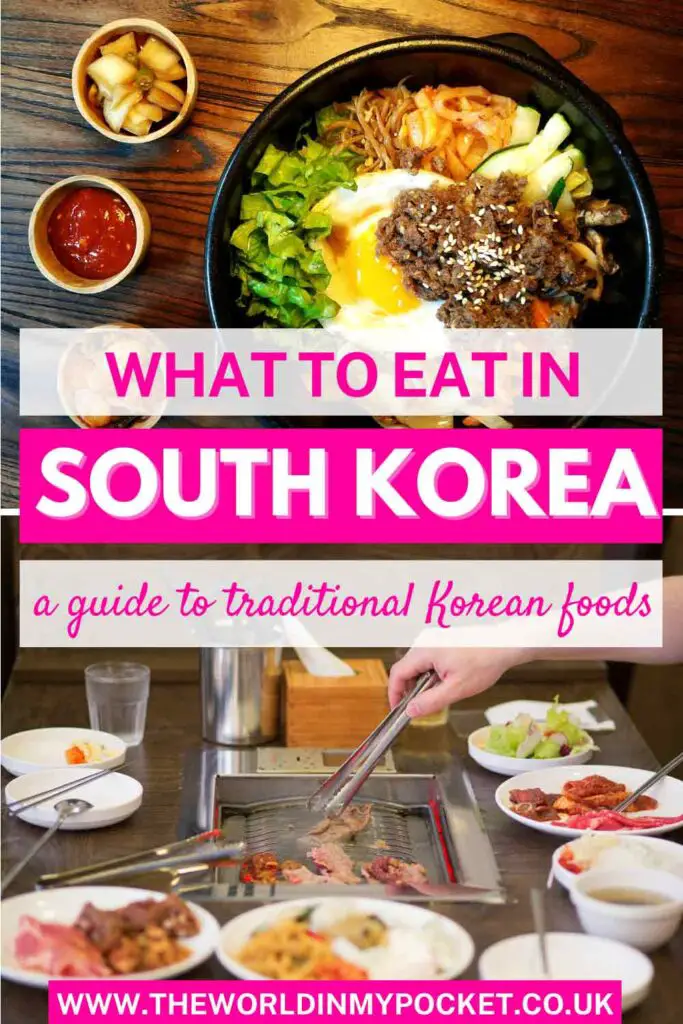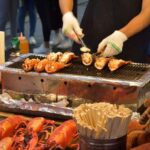One of the major draws of visiting South Korea for travellers from all over the world, is the chance to experience first-hand the incredibly delicious and vibrant cuisine of the Korean Peninsula.
This article is going to provide you with a comprehensive list of what to eat in Korea. A little history of Korean cuisine to start out, before diving right into some of the staple dishes in Korea. The article is then rounded out with suggestions of the best desserts to try in South Korea as well as recommendations for Korean drinks to wash it all down with.
From the world-renowned Korean BBQ and bibimbap, to lesser known treats like gimbap and hotteok, Korea is bursting with amazing culinary delights. The only question is where to begin?
So, let’s dive into: What to Eat in South Korea
About the Cuisine in Korea

Korean cuisine is renowned for being one of the most vibrant and delectable cuisines on the planet. In fact, for such a small country, South Korea has had an extraordinary impact on the world’s culinary scene.
The majority of food to eat in South Korea is largely based on staples such as rice, vegetables, seafood and meat – usually in great quantities. Dairy products like cheese and milk aren’t too prevalent in most meals in the country.
Traditionally, meals in South Korea are served as a number of different side dishes accompanying the main steamed rice. Banchan, as it is called in Korea, often consists of a number of different types of Kimchi, dipping sauces, meats and seafood.
Virtually every dish in Korea comes with kimchi – salted and fermented vegetables, typically cabbage or radish based.
Street Food in South Korea

Korea has a hugely popular street food scene, with a number of locals in Seoul even foregoing a kitchen or cooking space in their own homes because they know the choices of Street food are so ubiquitous and cheap.
While the markets at Gwangjang in Seoul and Nampodong street in Busan, offer great variety in terms of street food, perhaps the best way to sample deliciously authentic Korean cuisine is to experience the best street food in Myeongdong.
Myeongdong is perhaps most famous for being the shopping centre of Seoul, but one of the best things to do in Myeongdong is to wander around the market at night-time, trying to sample as many of the famous Korean street food dishes as possible.
Here’s a rundown of all the street food in Korea you should try:
Gimbap (Rice and Nori Rolls)

The Korean take on Sushi, Gimpab (sometimes spelled Kimbap) is one of the healthiest Korean street food options.
Similar to sushi, it is made with cooked rice, rolled in mini sheets of seaweed or nori, and filled with ingredients like vegetables, meats and seafood. Served in bite-sized portions, gimbap is a really common ‘on-the-go’ snack for Koreans and is often the first answer to the question – what should I eat in Korea?
Tteokbokki (Spicy Rice Cakes)

Tteokbokki is one of the most popular street foods in Korea and you will find this traditional dish all over the Korean Peninsula.
Chewy rice cakes are formed into thin, oblong-shaped pieces and then tossed around in a fiery gochujang paste. Sometimes they are served alone, while others choose to serve them alongside spring onions (scallions), fried cabbage or even fried fish cakes.
Gochujang, the main flavouring of tteokbokki, is a staple flavour in Korean cuisine. It is essentially a sweet, savoury, spicy and fermented chilli paste that is added to many of the best things to eat in Korea.
Sundae (Korean Sausage)

Despite sounding like a refreshing ice-cream, a Korean Sundae is in fact a traditional sausage that is made by steaming or boiling the intestines of a cow or pig.
It represents a flavour that is very similar to black pudding in the UK and can be served in many different variations. It is not a Korean dish for the faint-hearted, but the locals seem to absolutely love it and you’ll find it on street corners from Seoul down to Busan.
Mandu (Korean Dumplings)

Whether they are boiled, fried or steamed, Korean Dumplings – Mandu – are one of the most appetising and flavoursome foods to try in South Korea.
The style of mandu varies between the different regions of Korea but in general mandu comes with one of two classic fillings, pork or kimchi. Each offer a distinctively unique experience that packs a punch when it comes to flavour.
Arguably the best thing about mandu is that while they are a great Korean street food option, they can also be enjoyed as a main meal in any restaurant throughout the peninsula. Mandu is certainly one of the more versatile foods to try in South Korea.
Main Meals in Korea
Street food is a great option ‘on-the-go’ in Korea, but what about the best Korean dishes to try in a restaurant?
In this section, the best main meals in Korea will be highlighted so you will know exactly what you should be ordering on your next trip to South Korea.
Korean BBQ

Probably the most-famous Korean dish of them all, Korean BBQ is more than simply a meal, it is a culinary experience that involves cooking your own food at the table before enjoying the fruits of your labour.
As a popular method of grilling meats (usually chicken, beef or pork), Korean BBQ is usually prepared on gas or coal grills that are cleverly built into the table itself. Korean BBQ is a fun and sociable meal in Korea that is great for large parties wanting to share a meal together.
Korean Fried Chicken

While the methods and flavours vary up and down the country, one thing remains the same, Korean-fried chicken is something you have to eat in Korea!
Interestingly, in South Korea you can eat Korean-fried chicken as a starter, a main meal or just a simple mid-afternoon snack.
Unlike fried-chicken in the West, Korean-fried chicken is often lighter and crispier as it isn’t heavily battered. Instead the sweet and spicy flavours of soy sauce, gochujang honey and garlic shine through.
Bibimbap (Mixed Rice Dish)

‘Bibim’ means ‘mixing’ and ‘bap’ means ‘cooked rice’. It’s simple then, bibimbap is a delicious mixed rice dish that is served all over South Korea – and the world, for that matter.
While the base of this Korean dish is cooked rice, the rest of the meal is certainly up for interpretation and every restaurant in Korea will have its own unique version or recipe. Typically though, bibimbap will contain cooked rice, mixed vegetables and gochujang, with a fried or raw egg and sliced meat being very common additions.
Bibimbap is a hearty Korean meal that comes in so many different varieties that it could be enjoyed by a number of different palettes.
Dak-galbi (Spicy Stir-fried Chicken)

Yet another variation on tasty Korean chicken dishes, dak-galbi is made by stir-frying marinated pieces of chicken alongside gochujang, sweet potatoes, cabbage and an assortment of other ingredients.
Similar to Korean BBQ, there are dedicated dak-galbi restaurants all over Korea, particularly prevalent in Seoul, where you sit around the stove in the middle of the table and prepare your very own stir-fried delights.
For those who aren’t familiar with dak-galbi, there is no need to panic. The workers in the restaurant will often come over and check that everything is going well and that the food is cooking nicely.
Budae Jjigae (Army Stew)

One of the newest additions to the Korean recipe repertoire is budae jjigae, commonly referred to as army stew.
It is a Korean fusion dish that began life at the end of the Korean War in the mid-1950s. When the American soldiers left the Korean peninsula, they left behind vast amounts of processed foods such as spam, sausages and baked beans.
The Koreans decided to utilise these foods by adding them to their own Jjigae (stew) along with instant noodles, kimchi and gochujang paste.
While rich Korean flavours and American processed foods seems like an unlikely combination, budae jjigae has stood the test of time and today represents one of those oddly unique foods to eat in South Korea.
Desserts in South Korea
It’s time for a quick round-up of the best desserts in South Korea. While sweet treats from all around the world can be enjoyed in Korea, this section will highlight the desserts that are considered Korean by food experts.
Hotteok (Korean Pancakes)

A sweet pancake that has origins in Korean Chinese cuisine, hotteok is one of the most popular sweet Korean street food snacks.
The floury, doughy pancake is often served hot with sugar and/or syrup inside, with a variety of different fillings and toppings depending on where in Korea you are choosing to try this delicious food.
The most traditional hotteok is stuffed with brown sugar, cinnamon and walnuts – creating an oozing, delicious and rich flavour that is sure to be a hit when you visit Korea.
Bungeoppang (Korean Fish-shaped Pastry)

It’s not very often that you come across a sweet pastry shaped like a fish, but that is exactly what bungeoppang offers.
Originating from the Japanese Taiyaki, bungoppang is served at street food stalls that use a grill similar to a waffle iron, but has a fish-shaped mould.
Traditionally, this exciting Korean food comes filled with a sweet, red-bean paste but nowadays you can find variants with fillings such as nutella, syrup or even green tea matcha pudding.
Dalgona (Korean Hard Candy)

While Dalgona coffee has recently risen to global fame thanks to its thick and fluffy peaks of whipped sugar and instant coffee, traditional Dalgona has been a popular street food in Korea since the early 1970s and continues to prove delicious to this day, particularly for the older Korean generation.
Sometimes called ppopgi, dalgona is a Korean hard candy made from melted sugar and baking soda that has had somewhat of a renaissance thanks to hit Netflix show ‘Squid Game’.
The finished product is served on a lollipop stick and will often come with a playful design on it. A fun game to play with dalgona is attempting to eat as much of the outside of the candy while keeping the design etched into the candy in-tact – it’s much harder than it sounds!
Traditional Korean Drinks
Of course, a list of all the best things to eat in Korea wouldn’t be complete without mentioning the traditional Korean drinks that should accompany these meals.
So, here is a quick rundown of the best traditional Korean drinks to try.
Soju

You won’t go a day in South Korea without seeing people drinking the country’s most famous drink – Soju. The colourless, clear alcoholic beverage is often referred to as ‘Korean vodka’ and can be bought from pretty much anywhere.
Varying in alcoholic strengths from 17% all the way up to 50%+, soju is perhaps most commonly consumed on its own from a shot glass, but the younger generation of Koreans tend to mix it in with their beer to give their drink an extra kick.
Matcha Drinks
While Matcha tea powder is of course a Japanese phenomenon at heart, matcha drinks are ubiquitous throughout Korea, with Seoul in particular being an easy place to locate dedicated matcha-cafes that serve a wide range of drinks and treats based upon the distinctive, green delight.
A Korean twist on a matcha drink is the Korean Matcha Latte, a creamy, rich, frothy drink that is the perfect substitute for a dessert.
Banana Milk
Banana Milk may not sound overly Korean, but it is certainly all the rage in the country today. The banana milk craze begin when the Korean government tried to encourage the population to drink more milk.
Local food and drinks company, Binggrae, decided to mix their traditional milk with banana flavourings to see whether more Koreans would drink milk this way. What followed was a banana milk craze that is still very popular to this day.
Walk into any GS25 or CU (Korean convenience stores) and you will see shelf after shelf dedicated to the humble banana milk, it’s pretty wild.
FAQs Regarding Food in Korea

Here are some answers to a few common questions regarding food in Korea to round-out this what to eat in South Korea article:
Is Korean food spicy?
In general, Korean food can be considered spicy due to the addition of chillies and spicy gochujang paste in many Korean dishes. With that being said however, as a tourist, you can often ask for a less-spicy version of a dish and the restaurant will be happy to oblige.
Is it easy to find vegetarian food in Korea?
It is true that meat and fish are a huge part of Korean cuisine and everywhere you go in South Korea you will be greeted by wafts of grilled meats and Korean-fried chicken, however, the majority of restaurants (Especially in bigger cities like Seoul, Busan and Daegu) will offer vegetarian options.
Quick tip: it is always best to double check whether a dish that says ‘vegetarian’ in Korea comes served with fish because often ‘vegetarian’ may actually just mean ‘no meat’ in reality.
What is a typical Korean breakfast?

You may have noticed that none of the Korean cuisine mentioned in this article reflects a typical breakfast, but that is simply because a traditional Korean breakfast looks very similar to any other meal. Banchan, small plates of Korean food, are often served alongside boiled rice as a breakfast in Korea.
For more articles on South Korea, check out the following:
Like it? Pin it!

Disclaimer: Some of the links on this website are “affiliate links.” This means that if you click on the link and do a purchase, I will receive an affiliate commission at no extra cost for you. This helps me keep my website running and continue to share my travelling knowledge with you. I thank you for booking your flights or hotels using the links on my website. Regardless, I only recommend products or services I use personally and believe will add value to my readers.


This brings back so many good memories. We’ve been to South Korea, my partner cooks Korean food, and I am a HUGE fan of Korean food. I agree with your description of Korean food, it’s all about big, bold flavors and fresh, healthy ingredients. I don’t mind the spice either cause it just goes so well with the flavors. I personally love Kimchi, korean fried chicken (my partner cooks that), bibimbap (another one that my partner cooks), and how can you say no to KBBQ? Also, those fish pancakes for dessert and a chaser of Soju. Delicious!
An excellent guide to help navigate around the mazelike world of Korean food. I have to admit that I wish i had this guide with me when I visited South Korea. I remember very distinctly kimchi at every meal and that I fell in love with Bibimbap on this visit.
Joanna, your post brings back my most memorable moment. I was invited for a conference in 2015 and I didn’t do any research on the country. So, as I landed in the day, we had to do lunch on our own. And along with a fellow Indian journalist and a croatian, we walked around the hotel in Seoul. None of us understood anything that was available, and apparently we ended up eating octopus in rich spicy gravy. Later, the guide kept explaining the food to us and that became a whole lot easier. But I don’t remember the pastry and the candy. Really, wish I could go again now that I have some experience.